Capsize intake test: CIT volume
Peter Lamont and Peter Carter
This test produces a value in litres that can be used to compare sea kayaks in terms of potential safety performance by measuring the water remaining in the cockpit after a capsize. The method uses empty boats and flat water, and therefore does not take varying loads and sea conditions into account, but provides baseline figures for comparison.
You are invited to measure your own kayak by the method described to compare it to those we have already tested. You might also find it instructive to measure the other volumes of your kayak for comparison.
We would be grateful for a copy of your results: your results might help influence someone to improve their kayak, and perhaps avoid a difficult situation in the future.
Equipment and site
You will need flat water, 50–60cm deep. Put a pole or stake at a convenient point, ensuring that it is vertical. You will also need bucket, sponge and measuring container (some buckets are graduated).
It’s useful to tie a loose line under the kayak, from one side to the other, at the cockpit. (Attach to deckline, cockpit handrail, or cockpit rim.) In place of a fixed pole, you can also use a light pole or bar fixed across the kayak cockpit.
Method
- Capsize the kayak
- Roll the kayak onto its side using the attached line and hold it as lightly as possible with the cockpit rim against the pole if you are using one, or by making sure that the bar across the cockpit is vertical. Brace the boat in position on its side with the least force, avoiding lifting or pressing down
- When water is no longer flowing into or out of the cockpit, roll the kayak upright and take it to the bank
- Measure the amount of water remaining in the cockpit
- Repeat the procedure so that you have at least five measurements for each side
- Calculate the average (and other statistics if you wish). Please send your result to either Peter Carter
 or Peter Lamont
or Peter Lamont  , together with all the individual measurements. We can then put your results on this page for others to see and compare
, together with all the individual measurements. We can then put your results on this page for others to see and compare
Any test should provide reproducable and consistent results. By applying the method with care you should get volumes that do not vary much. You can compare your results with those we have obtained below.
The safety performance of a kayak is distinct from its paddled performance, how the boat behaves in wind and waves. The safety performance normally starts following a capsize: how easy is it for the paddler or helpers to restore the craft and its crew? How quickly is it controllable?
Safety performance and paddled performance properties overlap a little, chiefly in regard to directional control, but otherwise are largely separate. A CIT result is not directly applicable in actual situations, but can indicate which kayaks might be easier to empty than others.
There will be an element of subjectivity in comparing the ease of emptying flooded cockpits of various sea kayaks, but there is no doubt about the differences between the extremes. Currently one extreme would be a kayak with only inflated bags or solid foam for buoyancy, and the other, one with a minimum volume cockpit (MVC: some versions are known variously as ‘integrated cockpit’ or ‘pod’) shaped to allow easy exit of water.
Sample results
| Boat | SkerrayRM | Sea Tiger | Platypus 5 | Voyager 3 | Norkapp (modified) |
Your kayak? |
|---|---|---|---|---|---|---|
| Compartment type | bulkhead | MVC | MVC | MVC | semi-MVC | |
| Manufacturer | VCP | UK Surf Skis | P Carter | P Carter | VCP (Aus licence) |
|
| Notes/special | coaming pole | coaming pole | ||||
| Country | Scotland | Scotland | Australia | Australia | Australia | |
| Experimenter | P Lamont | P Lamont | P Carter | P Carter | P Carter | |
| Aft compartment | 102.2 | 250.0 | 134 | 76 | ||
| Forward compartment | 56.9 | n/a | n/a | 60 | ||
| Centre compartment | no | n/a | n/a | 24 | ||
| Cockpit | 165.9 | 95.0 | 76 | 80 | 102 | |
| Total | 325.0 | 345.0 | 210 | 262 | ||
| Total buoyant | 159.1 | 250.0 | 134 | 160 | ||
| Non-buoyant (cockpit) | 165.9 | 95.0 | 76 | 80 | 102 | |
| Buoyant:non-buoyant ratio | 0.96 : 1 | 2.6 : 1 | 1.8:1 | 1.6:1 | ||
| % non-buoyant | 51.0 | 28.0 | 36.2 | 38.9 | ||
| Water (fresh/sea) | fresh | fresh | sea | sea | sea | |
| Starboard: volume 1 | 38.9 | 2.5 | 5.0 | 4.9 | 14.6 | |
| Volume 2 | 36.2 | 4.1 | 5.8 | 5.05 | 13.5 | |
| Volume 3 | 36.6 | 4.5 | 5.6 | 4.5 | 14.8 | |
| Volume 4 | 36.4 | 3.8 | 6.0 | 5.0 | 13.4 | |
| Volume 5 | 36.7 | 3.6 | 6.0 | 5.0 | 14.7 | |
| Port: volume 1 | 35.7 | 2.3 | 3.8 | 4.5 | 14.8 | |
| Volume 2 | 36.2 | 2.8 | 4.8 | 5.1 | 14.3 | |
| Volume 3 | 36.9 | 4.2 | 4.2 | 5.0 | 15.8 | |
| Volume 4 | 36.3 | 2.8 | 4.5 | 5.0 | 16.0 | |
| Volume 5 | 36.8 | 2.4 | 4.5 | 4.75 | 16.0 | |
| CIT Average | 36.7 | 3.3 | 5.0 | 4.9 | 14.8 | |
| Minimum | 35.7 | 2.3 | 3.8 | 4.5 | 13.5 | |
| Maximum | 38.9 | 4.5 | 6.0 | 5.1 | 16.0 | |
| Starboard w/o seat | 44.2 | n/a | n/a | n/a | n/a | |
| Port w/o seat | 40.6 | n/a | n/a | n/a | n/a | |
| Foam seat vol. | 7.8 | n/a | n/a | n/a | n/a |
All measurements are in litres
Notes
- The Sea Tiger used was a production version (Not available in Aus)
- Platypus 5 is a stretched BAT, intended as an instructor’s boat for training. The cockpit in this example is not in straight, hence the port/starboard discrepancy
- Volumes and ratios for Voyager have been mislaid, but are comparable to Sea Tiger’s
- The Nordkapp is an early (1978) Aus version, modified with third bulkhead and buoyancy material (expanded polyethylene) at the sides of the cockpit and beneath the seat
- The Nordkapp, Voyager 3 and Platypus 5 tested all have foot pumps
Pictures of testing
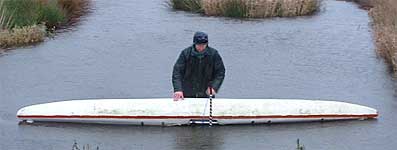
The Sea Tiger inverted in a Scottish duck pond...
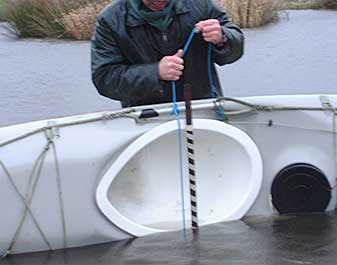
...and against the pole
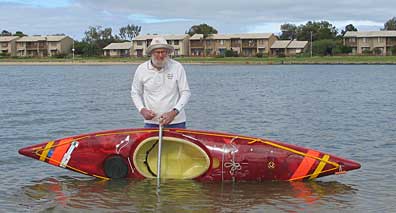
Platypus 5 on its side in West Lakes
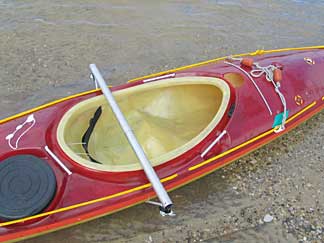
Platypus 5 integrated cockpit. The bar across the cockpit is a light aluminium tube
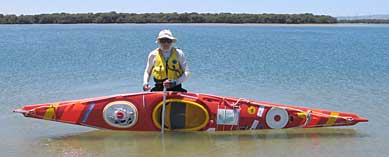
A Voyager 3 on its side at Garden Island, held by the tube across the cockpit
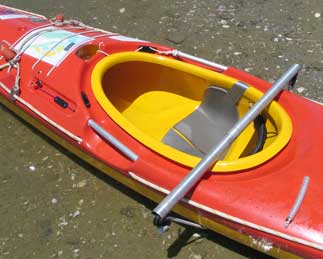
Voyager 3 integrated cockpit
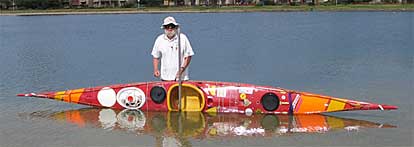
The Nordkapp floating on its starboard side
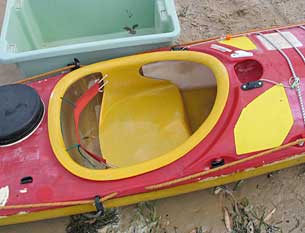
Nordkapp cockpit, with buoyancy material visible